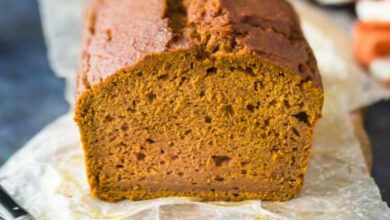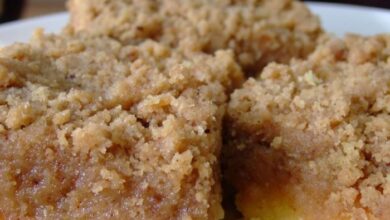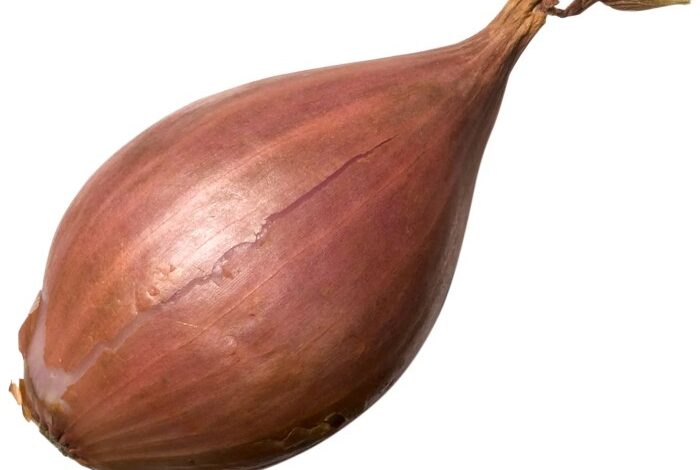
What is a Shallot: A Unique Member of the Allium Family
What is a shallot? It’s a culinary gem, often mistaken for a small onion, but boasting a flavor profile that’s both sweet and pungent, a delightful dance on the tongue. This unassuming bulb, with its papery skin and delicate shape, has been a staple in kitchens around the world for centuries.
It’s a versatile ingredient, lending its distinct aroma and flavor to countless dishes, from savory sauces and hearty stews to delicate salads and fragrant dips.
Shallots belong to the same family as onions, garlic, and chives, but they possess a unique character all their own. Their flavor is a subtle blend of onion and garlic, with a touch of sweetness and a hint of floral notes.
This complexity makes them a favorite among chefs and home cooks alike, adding depth and dimension to any dish they grace.
Introduction to Shallots
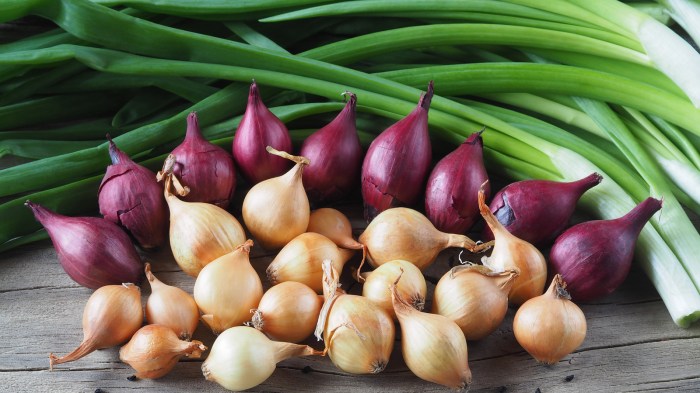
Shallots are a popular culinary ingredient known for their unique flavor profile and versatility in cooking. These bulbous vegetables belong to the same family as onions, garlic, and chives, adding a distinct aroma and taste to various dishes.
Botanical Classification
Shallots are classified as
- Allium cepa* var.
- aggregatum*, a variety of the common onion. They are a perennial plant that produces clusters of small bulbs, called “cloves,” which are typically harvested in the fall. The shallot’s botanical classification places it within the
- Allium* genus, which encompasses a diverse range of edible plants, each with its own unique characteristics.
Origin and History of Shallot Cultivation
Shallots are believed to have originated in Central Asia, specifically in the region encompassing modern-day Afghanistan, Iran, and Pakistan. They were cultivated in these regions for centuries before spreading to other parts of the world. Ancient civilizations, including the Egyptians and Romans, recognized the culinary value of shallots and incorporated them into their cuisines.
Distinguishing Characteristics
Shallots are distinguished from other alliums by their unique flavor profile and appearance. They have a milder, sweeter flavor than onions, with a hint of garlic and a subtle, delicate aroma. Shallots are also characterized by their elongated, pear-shaped bulbs that are composed of multiple cloves.
Shallots, those small, bulbous alliums with a milder, sweeter flavor than onions, are often used in sauces and dressings. They’re perfect for adding a touch of complexity to dishes like a low carb cauliflower mock potato salad , where their delicate sweetness balances the earthy notes of the cauliflower.
The next time you’re looking for a way to elevate your salad, try adding some chopped shallots for a burst of flavor.
These cloves are smaller than those found in onions and have a reddish-brown skin with a white interior.
Appearance and Characteristics
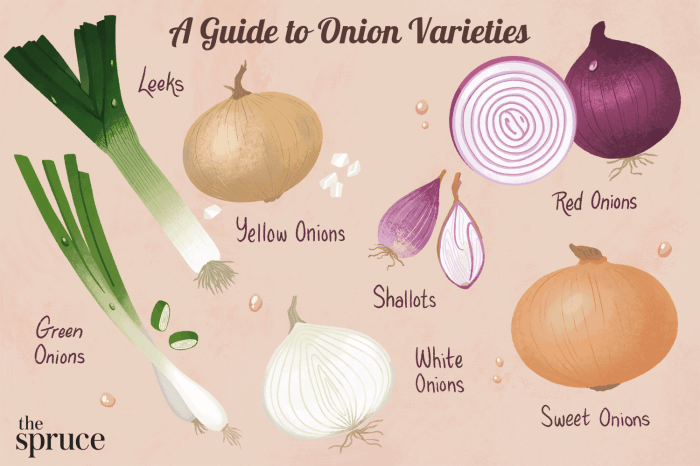
Shallots, a member of the allium family, are a versatile ingredient that adds a unique flavor to countless dishes. They are distinguished by their distinctive appearance, aroma, and flavor profile, making them a favorite among chefs and home cooks alike.
Physical Appearance
Shallots are typically small, elongated bulbs, resembling a small onion with a pointed tip. Their size can vary, ranging from about 1 to 3 inches in length. The skin of shallots can be a variety of colors, including shades of purple, red, bronze, and even yellow.
Shallots are a type of onion with a milder flavor than their larger counterparts. They’re often used in sauces and dips, but they also add a lovely depth of flavor to roasted vegetables. If you’re looking for a quick and easy side dish, try these rosemary potato wedges for the air fryer – they’re perfect for pairing with a shallot-based vinaigrette!
They are often sold in clusters, with several bulbs bundled together.
Aroma and Flavor Profile
Shallots possess a complex aroma that blends the sweetness of onions with a subtle hint of garlic. This unique combination makes them a valuable ingredient in both savory and sweet dishes. Their flavor is milder than garlic, but it offers a more pronounced sweetness compared to onions.
Texture and Consistency
Shallots have a firm texture when raw, with a slightly crisp bite. When cooked, they soften and develop a creamy, almost buttery consistency. Their texture can vary depending on the cooking method used. For instance, sautéing shallots will result in a tender, caramelized texture, while roasting them will yield a softer, more mellow consistency.
Culinary Uses
Shallots, with their delicate onion flavor and subtle sweetness, are a staple ingredient in kitchens worldwide. Their versatility extends from adding depth to simple dishes to elevating complex culinary creations.
Applications in Various Cuisines
Shallots are a beloved ingredient in diverse culinary traditions, lending their unique flavor profile to a wide array of dishes.
- French Cuisine:Shallots are a fundamental ingredient in classic French sauces like -sauce béarnaise* and -sauce bordelaise*. They are also commonly used in -soups, stews, and terrines*.
- Italian Cuisine:In Italian cooking, shallots often feature in -pasta sauces, risottos, and meat dishes*. Their delicate sweetness complements the richness of olive oil and the acidity of tomatoes.
- Asian Cuisine:Shallots are widely used in Southeast Asian cuisines, particularly in -Thai, Vietnamese, and Indonesian dishes*. They are frequently incorporated into -curries, stir-fries, and marinades*, adding a distinct aroma and flavor.
- Middle Eastern Cuisine:Shallots are a common ingredient in -Middle Eastern dishes*, where they are often used in -hummus, baba ghanoush, and various meat preparations*. Their mild onion flavor blends well with spices like cumin, coriander, and turmeric.
Versatility in Cooking Methods
Shallots adapt well to various cooking techniques, allowing chefs and home cooks alike to explore their flavor potential.
Shallots, those small, elongated bulbs with a flavor that’s both oniony and garlicky, are a staple in many cuisines. Their subtle sweetness and pungent aroma add depth to sauces, dips, and even main courses, like this delicious Thai style grilled pork tenderloin.
The shallot’s versatility extends beyond just flavor; its delicate texture makes it ideal for both raw and cooked applications, further solidifying its place as a kitchen essential.
- Sautéing:Sautéing shallots in butter or oil releases their aroma and creates a flavorful base for sauces, soups, and stir-fries.
- Roasting:Roasting shallots brings out their sweetness and creates a caramelized flavor that complements roasted vegetables, meats, and poultry.
- Pickling:Pickled shallots offer a tangy and refreshing contrast to rich dishes. They are often served as a condiment or used in salads and sandwiches.
Examples of Shallot Recipes
The versatility of shallots is evident in the wide range of recipes they enhance. Here are a few examples:
| Recipe | Description |
|---|---|
| French Onion Soup | Caramelized shallots form the base of this classic French soup, creating a rich and savory broth. |
| Chicken Piccata | Shallots add a delicate onion flavor to this light and tangy chicken dish. |
| Thai Green Curry | Shallots are a key ingredient in this aromatic curry, providing a subtle sweetness that complements the spicy and savory flavors. |
| Roasted Vegetable Salad | Roasted shallots add a touch of sweetness and depth to a simple roasted vegetable salad. |
Nutritional Value
Shallots, like other members of the allium family, are a powerhouse of nutrients and offer a range of potential health benefits. They are a good source of vitamins, minerals, and antioxidants, contributing to a healthy diet.
Nutritional Composition, What is a shallot
Shallots are low in calories and rich in various nutrients. Here is a breakdown of their key components:
- Vitamins:Shallots are a good source of vitamin C, an essential antioxidant that supports immune function and collagen production. They also contain vitamin B6, which plays a role in brain function and metabolism.
- Minerals:Shallots are rich in potassium, a mineral crucial for regulating blood pressure and muscle function. They also provide a good amount of manganese, which is involved in bone health and metabolism.
- Antioxidants:Shallots are packed with antioxidants, such as flavonoids and quercetin. These compounds help protect cells from damage caused by free radicals, reducing the risk of chronic diseases.
- Fiber:Shallots are a good source of dietary fiber, which aids digestion and promotes a feeling of fullness. Fiber also helps regulate blood sugar levels.
Potential Health Benefits
The nutritional profile of shallots suggests several potential health benefits:
- Heart Health:The potassium and flavonoids in shallots may contribute to heart health by reducing blood pressure and improving blood flow.
- Anti-Inflammatory Effects:Shallots’ anti-inflammatory properties, attributed to compounds like quercetin, may help reduce inflammation throughout the body, potentially lowering the risk of chronic diseases.
- Cancer Prevention:Some studies suggest that the antioxidants in shallots may have cancer-preventive effects.
- Improved Digestion:The fiber in shallots can aid digestion and promote regular bowel movements.
Comparison to Other Alliums
Shallots share a similar nutritional profile with other alliums like onions and garlic. However, they differ slightly in their nutrient content and flavor profiles.
| Nutrient | Shallots | Onions | Garlic |
|---|---|---|---|
| Vitamin C | Good Source | Good Source | Moderate Source |
| Potassium | Good Source | Good Source | Moderate Source |
| Fiber | Good Source | Good Source | Moderate Source |
| Antioxidants | High | High | High |
- Flavor:Shallots have a milder, sweeter flavor compared to onions and garlic, making them a versatile ingredient in both sweet and savory dishes.
- Cooking Properties:Shallots cook more quickly than onions and tend to retain their shape better during cooking.
Growing Shallots
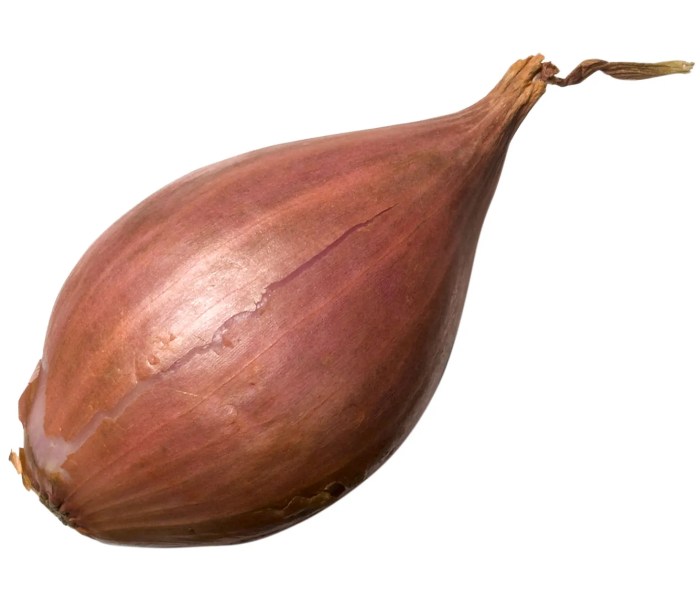
Shallots are relatively easy to grow and can be a rewarding addition to any garden. With the right conditions and care, you can enjoy a bountiful harvest of these flavorful bulbs.
Optimal Growing Conditions
Shallots thrive in warm climates with plenty of sunshine. They prefer well-drained soil that is rich in organic matter.
- Climate:Shallots prefer warm temperatures, with ideal growing conditions ranging from 60 to 80 degrees Fahrenheit (15 to 27 degrees Celsius). They can tolerate some frost, but prolonged exposure to cold temperatures can damage the bulbs.
- Soil Type:Shallots need well-drained soil to prevent root rot. A sandy loam or clay loam with a pH of 6.0 to 7.0 is ideal.
- Sunlight:Shallots require at least 6 hours of direct sunlight per day for optimal growth.
Planting Shallots
Shallots are typically planted in the spring, after the last frost has passed.
- Time of Planting:Plant shallots in the spring, after the last frost has passed, when the soil temperature reaches at least 60 degrees Fahrenheit (15 degrees Celsius).
- Planting Depth:Plant the shallots about 1 inch deep and 6 to 8 inches apart.
- Spacing:Space the rows 12 to 18 inches apart.
- Preparing the Soil:Before planting, amend the soil with compost or aged manure to improve drainage and add nutrients.
Cultivating Shallots
Proper cultivation is essential for healthy shallot growth.
- Watering:Keep the soil consistently moist, especially during the first few weeks after planting. Shallots require regular watering, especially during dry periods. However, avoid overwatering, as this can lead to root rot.
- Weeding:Regularly remove weeds to prevent competition for nutrients and water.
- Fertilizing:Apply a balanced fertilizer to the soil before planting. You can also side-dress with a nitrogen-rich fertilizer a few weeks after planting.
- Mulching:Applying a layer of mulch around the plants can help conserve moisture and suppress weeds.
Harvesting Shallots
Shallots are ready to harvest when the leaves begin to yellow and die back.
- Harvesting Time:Harvest shallots in late summer or early fall, typically 3 to 4 months after planting.
- Harvesting Method:Gently lift the bulbs from the soil using a garden fork.
- Storage:After harvesting, dry the shallots in a cool, dry place for a few days. Then, store them in a cool, dark, and well-ventilated area.
Pests and Diseases
Shallots are susceptible to a few common pests and diseases.
- Pests:Common pests include onion flies, thrips, and aphids.
- Diseases:Common diseases include downy mildew, leaf blight, and white rot.
Pest and Disease Prevention and Control
To prevent pests and diseases, it’s important to practice good sanitation and crop rotation.
- Sanitation:Clean up any plant debris after harvesting to reduce the risk of disease spread.
- Crop Rotation:Rotate shallots with other crops to break the disease cycle.
- Pest Control:Use insecticidal soap or neem oil to control pests.
- Disease Control:Treat fungal diseases with fungicides.
Storage and Preservation: What Is A Shallot
Shallots, like many other alliums, have a relatively short shelf life, but with proper storage and preservation techniques, you can extend their freshness and flavor for weeks or even months.
Storing Shallots
Storing shallots properly is crucial for maintaining their flavor and texture. Here’s how to keep them fresh for longer:
- Store in a cool, dark, and well-ventilated place:The ideal temperature for storing shallots is between 45°F and 55°F (7°C and 13°C). Avoid storing them in direct sunlight or near heat sources, as this can cause them to spoil faster.
- Store in a breathable container:A mesh bag, paper bag, or a loosely woven basket allows for air circulation, preventing moisture buildup and rot. Avoid storing shallots in airtight containers, as this can trap moisture and lead to spoilage.
- Separate damaged shallots:Any bruised or damaged shallots should be removed from the bunch and used first, as they are more susceptible to spoilage.
Preserving Shallots
Preserving shallots extends their shelf life and allows you to enjoy their flavor throughout the year. Here are a few common methods:
Drying
Drying shallots is a simple and effective way to preserve them.
- Air drying:Slice shallots thinly and spread them on a wire rack or baking sheet lined with parchment paper. Place them in a well-ventilated area out of direct sunlight and allow them to dry completely. This process can take several days to a week.
Dried shallots can be stored in an airtight container in a cool, dark place for up to six months.
- Dehydrator:Dehydrators are a more efficient way to dry shallots. Follow the manufacturer’s instructions for drying time and temperature. Dried shallots from a dehydrator can be stored in an airtight container in a cool, dark place for up to a year.
Pickling
Pickling shallots adds a tangy and flavorful twist to this versatile ingredient.
- Brine pickling:Combine water, vinegar, sugar, and salt in a saucepan and bring to a boil. Add shallots and simmer until tender. Store in sterilized jars in the refrigerator for up to 3 months.
- Quick pickling:This method uses a simple mixture of vinegar, sugar, and spices to pickle shallots quickly. Store in sterilized jars in the refrigerator for up to 2 weeks.
Freezing
Freezing shallots is a convenient way to preserve them for future use.
- Blanching:Blanch shallots for a few minutes in boiling water, then immediately plunge them into ice water to stop the cooking process. Drain well and freeze in a single layer on a baking sheet. Once frozen, transfer them to freezer bags or containers for storage.
Frozen shallots can last up to 6 months.
- Freezing without blanching:This method is suitable for quick recipes where blanching is not necessary. Chop or slice shallots and freeze them in a single layer on a baking sheet. Once frozen, transfer them to freezer bags or containers for storage. Frozen shallots can last up to 3 months.



